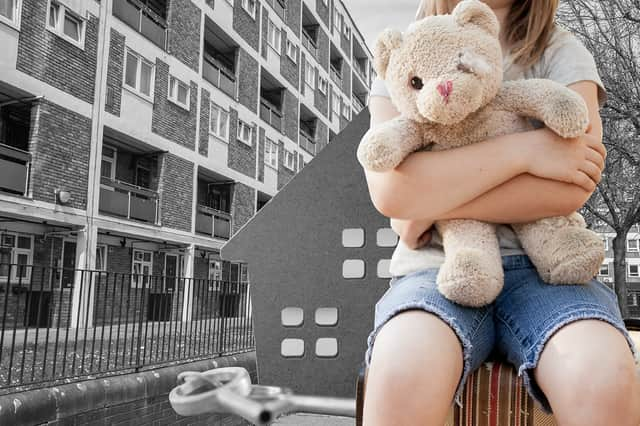Right to Buy scheme: 55,000 social rented homes lost in England since 2012 as charity calls plan ‘unworkable’


Around 55,000 social rented homes have been lost and not replaced in England through Right to Buy since 2012 – enough to house nearly every family with children stuck in B&Bs and other temporary accommodation.
It comes after the Government announced on Thursday (9 May) new plans to extend Right to Buy beyond council properties to housing association tenants, with a promise that every home sold will be replaced.
Advertisement
Hide AdAdvertisement
Hide AdHousing charity Crisis said the policy had not been thought out and would not address huge problems across the social housing sector, adding it was "unrealistic" to think the sales would not lead to a further reduction in housing supply.
Analysis of Department for Levelling Up, Housing and Communities (DLUHC) data by NationalWorld shows as of April 2021, 131,000 ‘low cost rent’ homes had been sold through the Right to Buy scheme since April 2012, when the level of discount available to buyers was increased dramatically by David Cameron’s government.
Social rent is the cheapest type of social housing. While ‘low cost rent’ homes could also include ‘affordable rent’ and ‘intermediate rent’ tenants (who pay up to 80% of market rates) it is largely just social rent tenants with secure tenancies who have been eligible for Right to Buy, according to Crisis.
A small number of non-social rent homes sold to housing association tenants in a pilot of the scheme’s extension may be included.
Advertisement
Hide AdAdvertisement
Hide AdSeparate data from the DLUHC shows only 76,000 new homes for social rent have been created since 2012, either through building or converting other properties – leaving a net loss of roughly 55,000 of the most affordable homes.
Loading....
The Department’s figures show 58,600 families with children were stuck in insecure temporary accommodation such as hostels or B&Bs at the last count in December 2021, alongside 37,800 households without children.
That means almost as many homes will have been lost to Right to Buy since 2012 as there are families with children in temporary accommodation – although there is no guarantee the homes sold through the scheme will have been family-sized properties.
Overall the net reduction of social rent homes since 2012 is equivalent to 57% of the total number of households in temporary housing (96,410).
Advertisement
Hide AdAdvertisement
Hide AdMore homes have been sold than created for the last eight consecutive years.
The figure of 131,100 lost social rent homes only includes those specifically sold through Right to Buy. The Chartered Institute for Housing says there have also been tens of thousands of social rented homes sold for other reasons, converted into more expensive housing, or demolished since 2012, leading to a net loss of over 200,000 homes as of April 2020.
Loading....
Government plans to extend the Right to Buy scheme to housing association tenants were announced by Prime Minister Boris Johnson earlier this week, opening it up to 2.5 million additional renters.
“Social housing will always play an important role in our society, so the Prime Minister will also commit to the building of replacement social homes for each one sold,” a government announcement stated.
Advertisement
Hide AdAdvertisement
Hide AdBut it did not promise homes would be replaced on a like-for-like basis. Councils and housing associations frequently replace cheap social rented homes sold through Right to Buy with more expensive ‘affordable rent’ units, or properties for Shared Ownership.
Social rent homes make up an increasingly small number of so-called ‘affordable homes’ built or created in England.
In 2020-21, just 5,955 social rent homes were built, only 11% of total new affordable homes. That compared to 37,677 (65%) in 2011-12.
Loading....
Francesca Albanese, head of research for Crisis, said the Government’s plans were “unworkable” and would not address huge problems in the housing sector, such as the tens of thousands stuck in temporary accommodation.
Advertisement
Hide AdAdvertisement
Hide AdMost social housing tenants are unable to put savings away, she added, with the cost of living crisis meaning many are choosing between heating and eating, raising questions about how they could afford to purchase their homes in the first place.
“In that context, we think this has not been thought through,” she said.
Kiran Ramchandani, director of policy and external affairs at Crisis, added: “The reality is that with housing benefit currently frozen, it’s barely enabling anyone to rent as it is.
“To suggest this money can now be used to secure mortgages without a costly investment to the benefits system is an utter fallacy.
Advertisement
Hide AdAdvertisement
Hide Ad“The only way to fix our broken housing system is to build more social homes which people can afford – we urge the Government to get on with doing this if we’re ever going to end homelessness for good.”
When announcing the scheme’s extension, Boris Johnson said: “Just as no generation should be locked out of home ownership because of when they were born, so nobody should be barred from that same dream simply because of where they live now.
“For four decades it has been possible for council home tenants to use a discount to buy the property they live in.
“Over that time almost two million people have been helped into home ownership.
Advertisement
Hide AdAdvertisement
Hide Ad“They have switched identities and psychology, from being dependent on the state for every repair – from damp-proofing to a new front door – to being in charge of their own family home, able to make improvements and add value as they please.”
Comment Guidelines
National World encourages reader discussion on our stories. User feedback, insights and back-and-forth exchanges add a rich layer of context to reporting. Please review our Community Guidelines before commenting.
